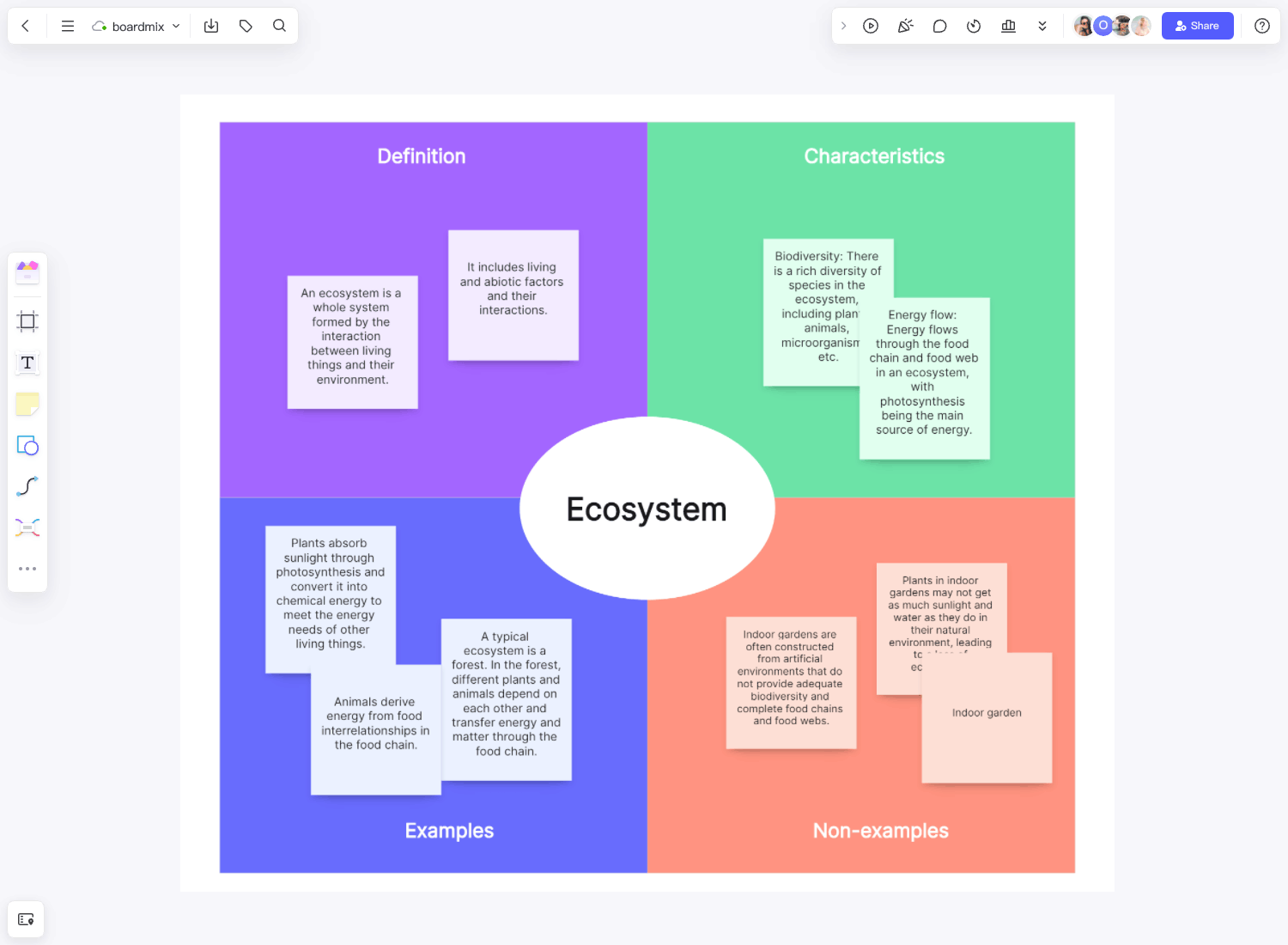A Frayer model might come in handy when you want to understand context and topics in its simplest form. The template is also helpful to children when learning new content. The model is also a versatile diagram that can be used in the classroom setting and other areas to understand concepts deeply. The template is even easier to create, so you’ll get the hang of it quickly. Continue reading this article to know more.
What is a Frayer model?

Make Your Frayer Model for Free
A Frayer model is a graphic organizer which was created in 1969. Since then, it has been significantly used in the classroom, and until today, most learners still rely on the model in specific situations, especially when learning new things.
A Frayer model template has four squares and a small oval at the center. The quadrants determine, analyze, and clarify word meanings and structure. The oval is where you will place the word or topic to focus on. The model generally focuses on one word with a defined sequence and technique to analyze the meaning of a word.
Various Frayer Model templates online allow you to include special characters like stickers, photos, or illustrations to help visualize the specific word. These software are editable, so you can customize them however you like.
When to use a Frayer model?
As previously mentioned, one uses the Frayer model usually in teaching lessons to introduce new terms in content. The model is generally valuable for elementary and secondary levels. Here are some aspects and subjects in the classroom where the Frayer model is beneficial.
- English Language Arts. There are concepts in the subject where it can be challenging to understand. Using a Frayer model template, you can break down the concept’s components into simplified parts. The model is beneficial in specific topics, including character analysis and literary element examples.
- This subject is vast, and digesting everything will take time. You can simplify text analysis, significant events, and other arguments written in historical documents through a Frayer model template. Also, the template will help highlight the importance of historical events.
- Foreign Language. When learning a language, you’ll always have to handle vocabulary. After all, there are new terms for you to know. The Fray model is beneficial to understanding unfamiliar words better than merely reading a dictionary.
- STEM (Science, Technology, Engineering, and Mathematics. STEM is generally a complex subject considering it involves various specializations. You can simplify some terms and lessons into more digestible chunks. The template is also useful for students to review before starting a related topic.
Besides the classroom setting, the Frayer model template is also beneficial for companies that aim to establish connections between two factors affecting their business. They can compare attributes to formulate effective business strategies.
What are the main components of the Frayer model?
The typical Frayer model comprises four sections. Check the list below.

- It’s generally placed at the center of the diagram. What’s written in the oval is the word involved.
- This first quadrant must describe the meaning of the word or concept you must digest. The definition can come from the student, teacher, or anyone creating the Frayer model template.
- You’ll need to provide concrete examples to describe the word or concept. Some creators use illustrations, shapes, stickers, and photos to represent the word correctly.
- Non-examples. It’s the opposite of examples.
- The details in this final quadrant can be the creator’s actual observations or inputs about the word.
Some Frayer model templates can also use essential and non-essential characteristics to replace the definition and characteristics quadrants. It depends on the template you use. The bottom line is to break down complex and unfamiliar words and ideas into simple ones.
Benefits of using the Frayer model
Here are some essential reasons why the Frayer model is beneficial to almost everyone.
- The model simplifies complex concepts. Since you’re giving clear definitions, it’s easier to understand the words and ideas and distinguish them from related concepts.
- It lets you explore the features. As you simplify and delve deeper into the concept, the audience can familiarize themselves with the distinct features to better understand it.
- The template provides concrete examples for the audience’s guidance. As you know, the template requires providing examples. These can help the audience connect the word or concept to real situations. When better illustrated, these examples also help simplify the complex idea.
- It allows you to make specific comparisons. The non-example quadrant of the model gives your audience a better view of the boundaries and scope of the concept involved. It will also bridge confusion gaps with other closely related concepts.
- It’s convenient and practical. Creating the model does not need too many resources. You can draw it directly on a piece of paper or sketch it through diagramming tools online.
How to use a Frayer model in your class?
The following are some tips on how to use the model in the classroom. These are just suggested steps; you can add more if you like them.
- Select vital concepts and create copies of the Frayer Model template.
- Distribute the copies to participants and explain the process. If you’re using digital templates, you can provide the link to the template.
- Assign one key concept to a group or pair and have them fill in the model's four components. You can also assign the task individually.
- Allows the participants to share their finished models with the entire class. Ensure they provide conclusions about the assigned concepts.
- If it helps, the teacher or moderator can also make copies of the Frayer models as future references for the participants.
Frayer model Templates in Boardmix
Frayer Model Example 1
As a teacher, explaining the concept of mathematical even numbers to elementary school kids using the Frayer Model would go like this:

Make Your Frayer Model for Free
-Term: Even numbers
-Description: Even numbers are numbers divisible by 2.
-Characteristics: Any number divisible by 2 without remaining. 1 is not an even number. Numbers gotten from multiples of 2 can be called an even number.
-Examples: 2,4,6,8, 10,12,14, 16, 18,20
-Non-examples 1, 3, 5, 7, 9,11,13,15,17,19
Frayer Model Example 2
If the concept of mathematical inequality expression is to be explained to basic college students using this model, it should be stated like this;
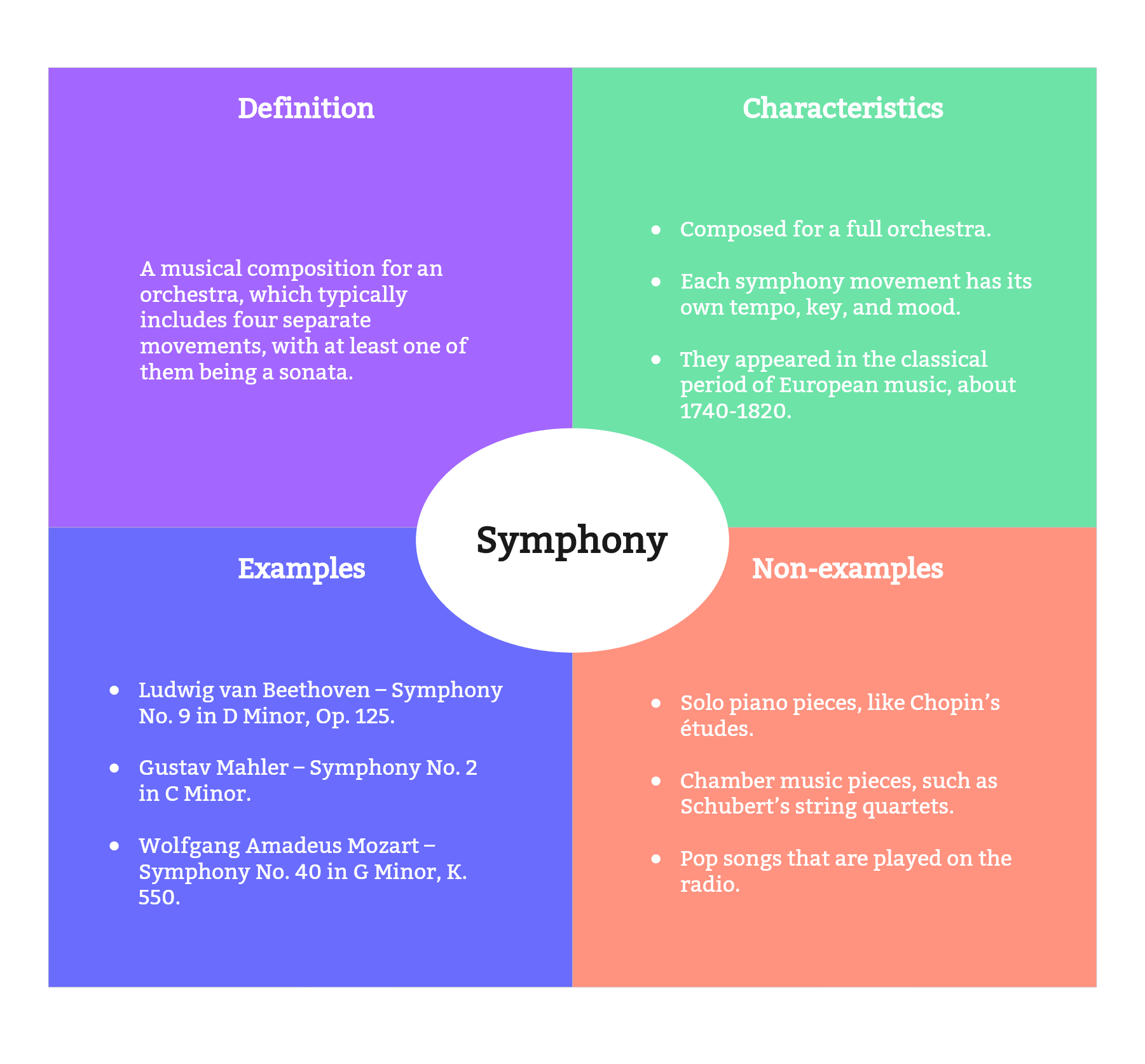
-Term: Inequality expression
-Description: They’re signs used in comparing relationships between two values that are not equal to each other. For example, if you want to buy a gamepad that costs $100, but you only have $75, it’s inequality if you compare values 100 and 75. In essence, 100 is greater than 75.
-Characteristics: When you see ‘=’, it means two values are equal. If two values are not equal, the first value is greater than > or less than < the second value. ≥ means greater than or equal to while ≤ means less than or equal to.
-Examples: 4+1 ≠ 3, 7>4, 6+2=8-6, x ≤ 9, etc
-Non-examples: √4 , x cosx, x⅛, etc
Frayer Model Example 3
This Frayer model example shows an illustration of the concept of improper fractions for kids.
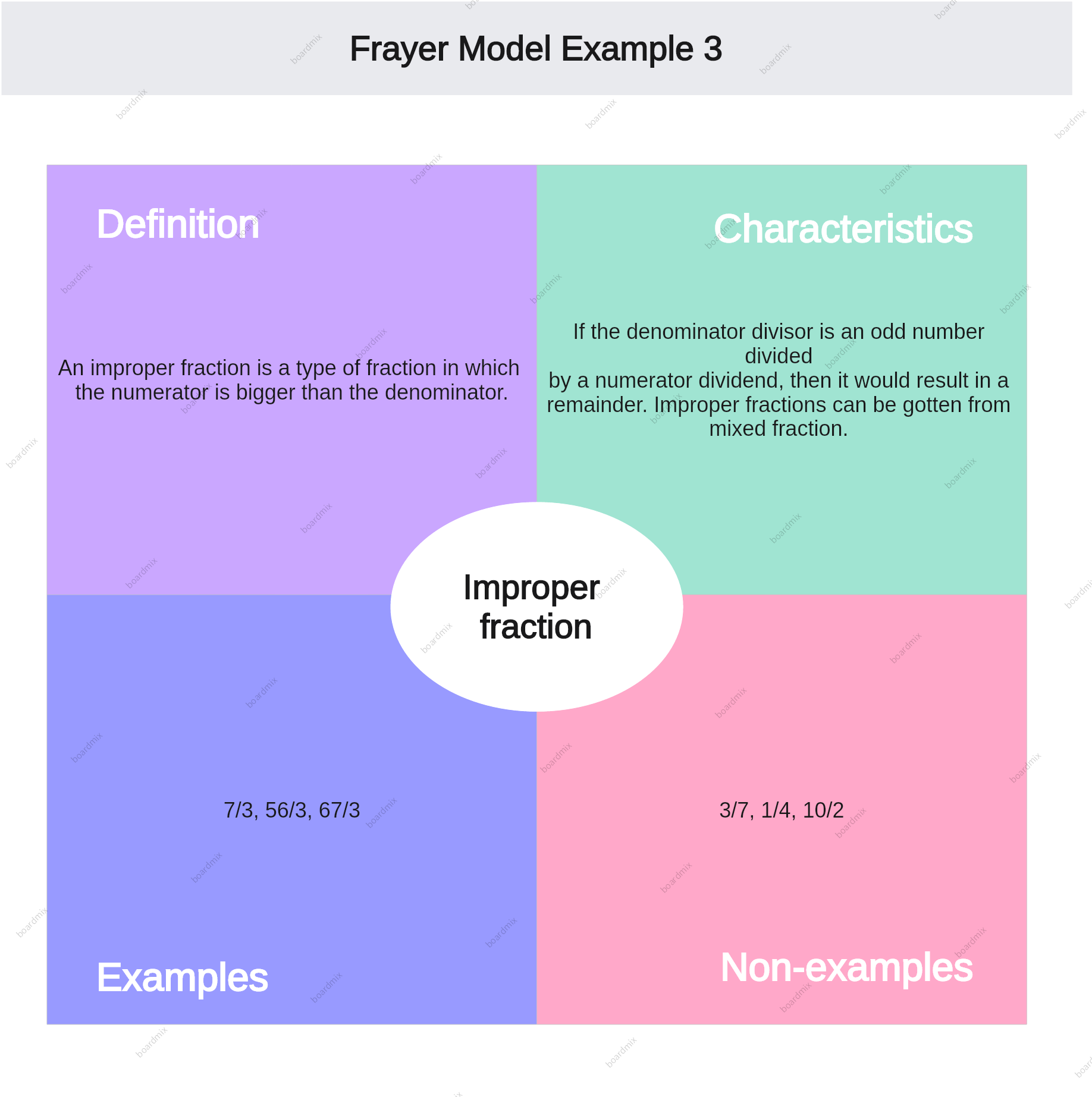
Make Your Frayer Model for Free
--Term: Improper fraction
--Definition: An improper fraction is a type of fraction in which the numerator is bigger than the denominator.
-Characteristics: If the denominator divisor is an odd number divided by a numerator dividend, then it would result in a remainder. Improper fractions can be obtained from mixed fractions.
-Example 7/3, 56/3, 67/3
-Non-Examples 3/7,1/4, 10/2
How to make a Frayer Model with Boardmix Graphic Organizer?
Boardmix, known for its comprehensive suite of graphic organizer tools, offers an easy-to-use Frayer Model graphic organizer. This effective tool can maximize your learning experience by simplifying complex concepts into understandable parts. Here's a step-by-step guide on utilizing Boardmix's Frayer Model graphic organizer.
1. Log In to Your Boardmix Account
Visit the Boardmix website and log in to your account. If you haven't registered yet, take a moment to sign up – it’s free!

2. Create a New Project
Select Plus Board from your dashboard to open a fresh canvas for your Frayer Model graphic organizer.

3. Choose the Frayer Model Template
Boardmix offers a variety of graphic organizer templates. Locate and select the Frayer Model from the template library.
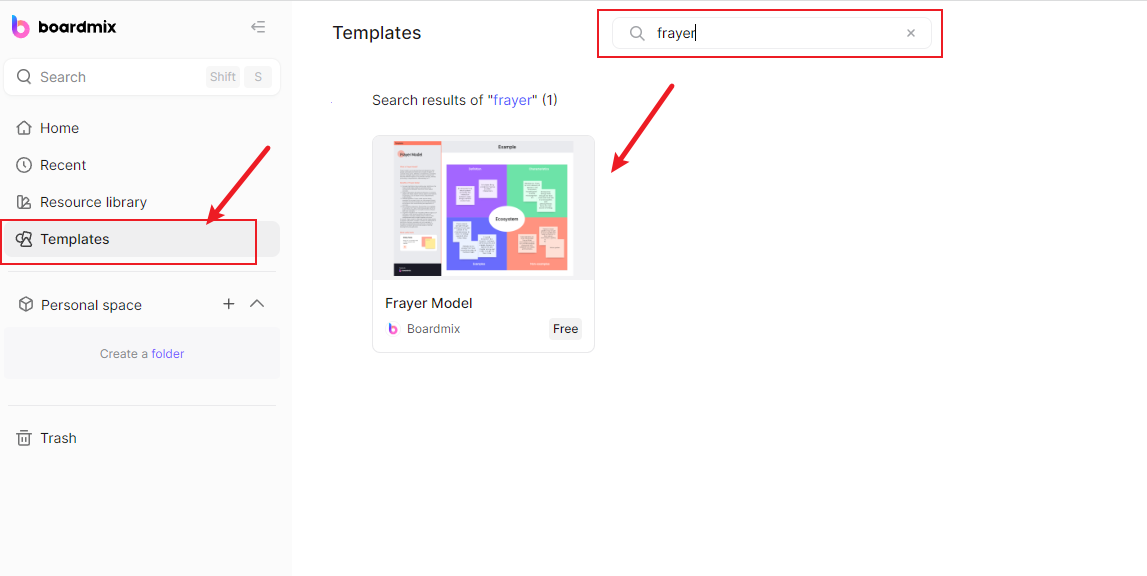
4. Input Your Concept
The central concept or term goes in the middle of your Frayer Model organizer. Simply click on the text box and type in your chosen concept.
5. Fill in the Quadrants
Your Frayer Model is divided into four sections or quadrants, each serving a specific purpose:
- Definition: Type in the meaning of your chosen concept here.
- Characteristics: List down the attributes or characteristics of the concept in this section.
- Examples: In this quadrant, provide examples that align with the concept.
- Non-Examples: Finally, provide instances that do not conform to your chosen concept. This will clarify what the concept is not.
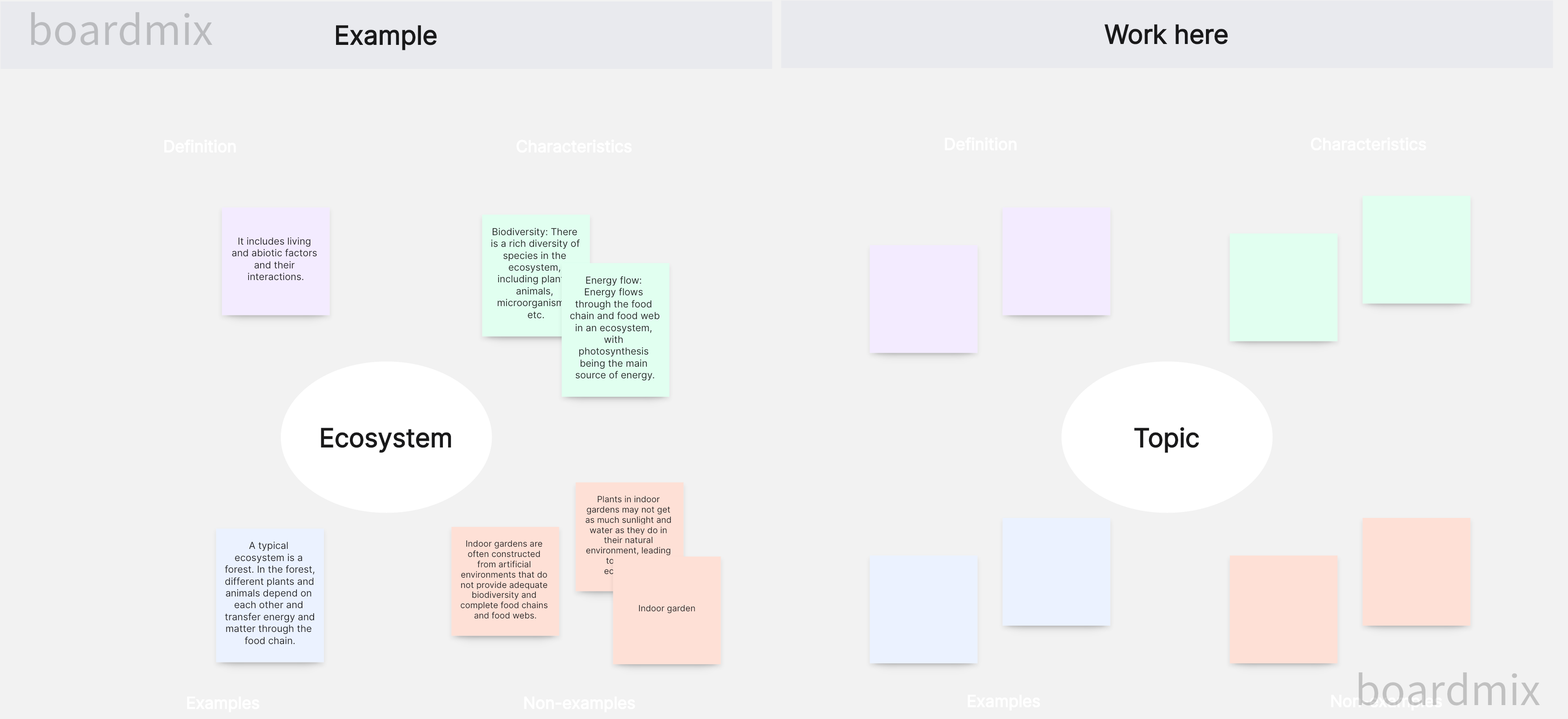
6. Customize Your Frayer Model
You can change the font size, color, or style for better visibility and understanding. Additionally, you can add images or icons for a more engaging learning experience.
7. Save Your Work
Click 'Save' to secure your progress and keep your work safe.
8. Share Your Work (Optional)
If you want to share your graphic organizer with others, you can do so via email or a shareable link.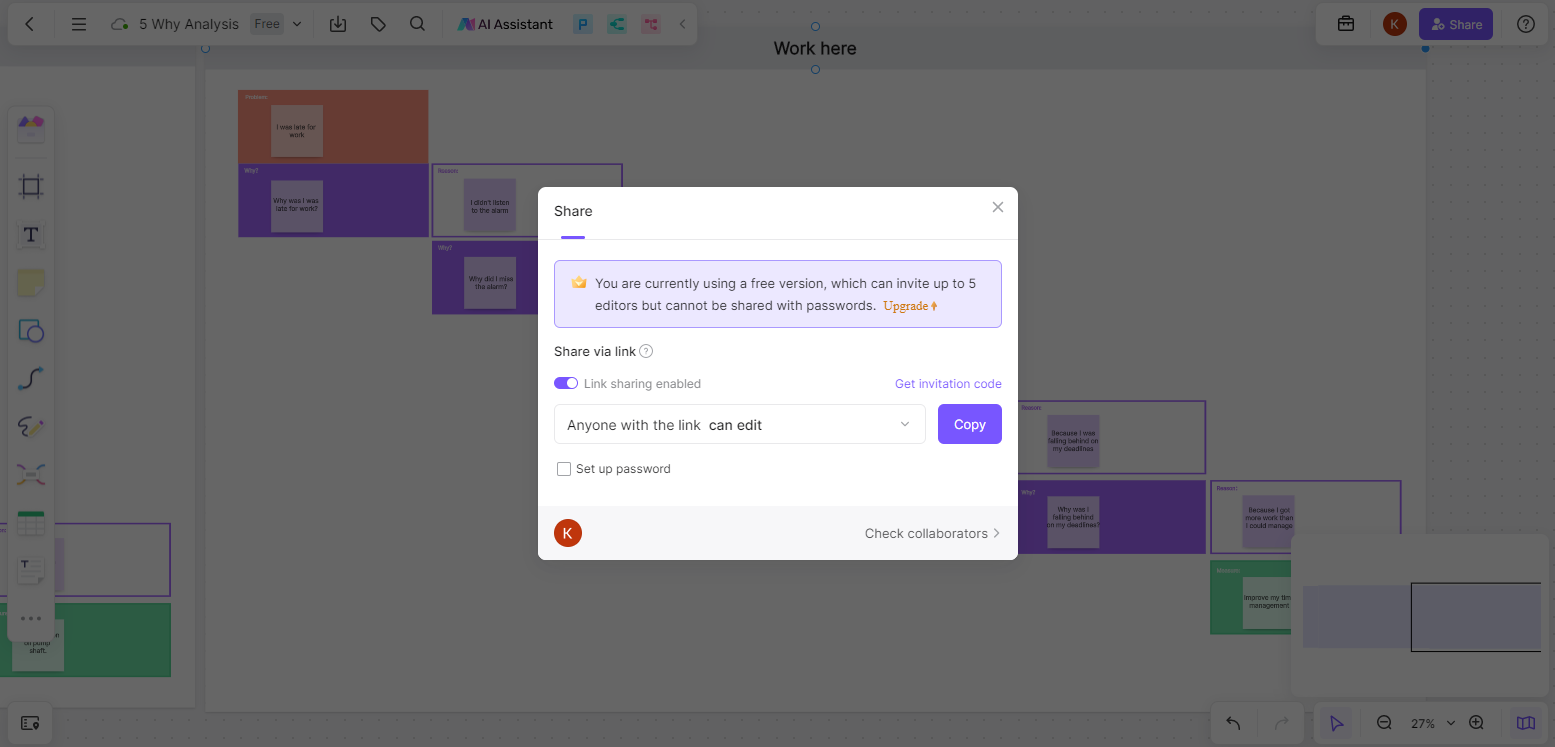
The Boardmix Frayer Model graphic organizer is an exceptional tool for enhancing comprehension, promoting active learning, and improving memory retention. With its intuitive interface and customizable features, Boardmix transforms learning into an engaging and enjoyable process. So why wait? Start your journey towards maximized learning with Boardmix today!







